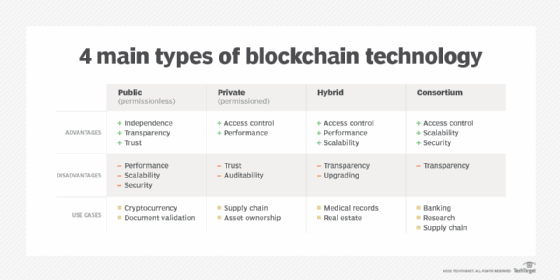Tech
Understanding Blockchain Uses in Data Centers

As with every trend, Blockchain The technology has its fair share of pros and cons, especially in the context of the data center. However, the growing influence of blockchain can provide organizations with a competitive advantage when applied appropriately.
Today, blockchain technology is one of the most important trends in the industry. According to an online survey of over 600 business decision makers commissioned by Casper Labs and performed by Zogby Analytics, 86% of respondents said they would be more interested in implementing blockchain if there was a hybrid option for their organizations to securely migrate data between private and public environments. The most commonly cited blockchain use cases among respondents were security, copy protection, and database management.
The recent blockchain technology
Blockchain is a highly secure and immutable data storage technology. Malicious individuals cannot break into the system or falsify the data stored in it. distributed ledger technology records transactions and related data in multiple places at once, which prevents a single point of failure and validates every piece of information stored.
Compared to traditional databases that store data in rows, columns, tables, and rows, a blockchain is decentralized and managed by computers in a peer-to-peer network. It stores data in chained blocks; during a transaction, each block of data is sent to every computer node in the network, where it is authorized and then securely linked to the blockchain. Once added, a block cannot be changed.
The validation process ensures that the data is unique and legitimate, with timestamps to prove it. If someone tries to replace a block, copy it, or change its state, the network of computers that make up the blockchain is immediately notified, and no one can add new blocks to the chain until the problem is solved.
Safety is easy The biggest advantage of blockchainfollowed by resilience. Each block is continuously reconciled by a network of computers. If one node fails, it cannot bring down the entire system because all the other nodes have a copy of the ledger.
The unique features of blockchain can increase trust, security, transparency and bring other benefits to businesses.
There are different types of blockchain and a variety of usable in all sectors. The financial industry is currently leading the way in adopting blockchain because of how the technology simplifies and secures the transaction process.

There are four main types of blockchains. They vary in how open or closed they are, which affects their speed, privacy, and security.
How Blockchain Is Transforming Data Center Architecture
In terms of data center architecture, blockchain takes a different approach to data storage.
Blockchain uses decentralization to manage and store data. The blockchain network can consist of tens, hundreds, or thousands of computers distributed around the world in various locations. For a blockchain breach to be successful, hackers would have to take down multiple computers in the network, and even then, blockchain data storage It is encrypted, which minimizes security risks.
These benefits compete directly with traditional data center storage. Data centers house massive amounts of data in one location. This centralization exposes them to the risk of natural disasters and local area outages. To add some redundancy and prevent data loss, organizations could copy data and store it in other locations. However, this process can be time-consuming and expensive, and creates a surplus of information that also needs protection.
The rise of blockchain also requires more reliable power supplies, high-performance equipment that can quickly process blocks of data, and more intensive cooling to prevent equipment from overheating during intensive calculations.
Blockchain data storage can provide higher levels of security, reliability, redundancy, resilience, and transparency. Its distributed nature allows users to have a higher level of control over where their data is stored, which also impacts accessibility and availability.
That said, accessibility and availability can be a detractor from the decentralized approach. To retrieve a block of data, different nodes on the network must synchronize, validate, and mine the block. This can take a significant amount of time, depending on the locations and loads of the nodes. Traditional data centers can offer much higher speeds and higher levels of data availability.
THE blockchain securityWhile quite advanced, it is not perfect. As more users adopt the technology, bad actors will become better at finding and exploiting holes in blockchains. For now, however, it provides much better data security than in-house and cloud storage.
Use these security tips to prevent attackers from exploiting vulnerabilities in your blockchain technology.
Finally, cost is a major factor that determines whether organizations might choose to adopt blockchain. Although blockchain is becoming more popular every day, it is still not widely deployed by organizations, at least not to the same extent as cloud storage, which is cheap and available in many forms today.
How Data Centers Can Stay on the Cutting Edge
For data center teams looking for a blockchain-based approach, start by re-evaluating your data center infrastructure. Consider how to pivot resources and begin implementing and moving toward a decentralized architecture. Start thinking about how to set up a peer-to-peer network that can handle a blockchain-based workflow.
THE rise of blockchain It also requires more reliable power, high-performance equipment that can process blocks of data quickly, and more intensive cooling to prevent that equipment from overheating during intensive computations. The faster users can write and validate blocks, the better. So, be sure to consider these requirements and invest accordingly.
Traditional data center architecture must radically transform to meet the demands of increased blockchain traffic and availability, including the availability of staff on hand with specialized blockchain skills. This is a daunting undertaking; but by planning now, organizations can keep pace with growing data processing demands and adapt to customer needs as they adopt new business strategies to integrate blockchain.
Editor’s Note: This article was updated in July 2024 to improve reader experience.
Jacob Roundy is a freelance writer and editor specializing in a variety of technology topics, including data centers and sustainability.
